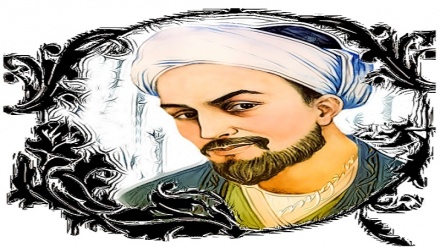Iranian notables, sources of global honor (79)
Today, we become familiar with “Loghat-e Moran” Treatise, penned by the acclaimed Iranian mystic, Sheikh Shahab Ed-Din Sohravardi.
Today, we continue to study the works and services of the Iranian philosopher and mystic, Sheikh Shahab Ed-Din Sohravardi, who lived in 6th Century AH and earned the title of Sheikh Ul-Eshraq. He highly contributed to the development of Islamic philosophy and mysticism and is the founder of the one of the most important schools of thought of Islamic philosophy, referred to as “Illuminism”.
It was said that Sohravardi was born in the Village of Sohravard, in the vicinity of city of Zanjan in the year 549 AH. He was murdered at the age of 38, in the year 587 AH, upon the conspiracy of the scholars of city of Aleppo, and the instruction of the Founder of Ayoubi Dynasty, Salah Ed-Din Ayoubi. Sohravardi has left behind several books. Parts of his works are allegorical treatises and stories which have been authored in cryptic language. In the view of researchers, these works present a true image of this celebrated mystic. These works which have been presented in a beautiful and delicate cryptic language, present a number of the spiritual and inner experiences of Sohravardi. We also spoke of the reasons behind the tendency of this mystic to cryptic language and figurative speech, and pointed out the impacts of the cryptic language of Sohravardi on the great Farsi men of letter, such as Molavi, Attar, and Hafez, while introducing his book, referred to as “The Chant of Gabriel’s Wing”.
Loghat-e Moran is a treatise in Farsi language, authored by Sheikh Shahab Ed-Din Sohravardi. This treatise has been printed on several occasions. In the year 1935, this treatise was published in an Asian magazine, coupled with its French translated script. Dr. Seyed Hussein Arab edited and printed this text.
Loghat-e Moran is a Farsi treatise of Sheikh Ul-Eshraq, which contains a mystic text. He has penned this book upon the request of one of his friends. He has started the text of this treatise under the name of God and by hailing the Prophet of Islam, Mohammad (Blessings of God upon him and his progeny), which in turn goes to show his faith in God and the sacred religion of Islam. The status quo of his community compelled him to make his remarks via usage of cryptic language.
In this treatise, Sohravardi speaks in the so-called language of ants and uses a cryptic language.
Ants, in order to find food, go to plains and deserts every day and endure many difficulties and hardships. The same ants became the guides of Solomon and save him. In this treatise, Sohravardi presents other accounts from the mouths of animals, insects, ducks, turtles, bats, and owls.
In general, the subject of this treatise revolves round the path which the wayfarer has to cover to let go of his worldly belongings, and to narrow his distance with God. He has presented this text coupled with a number of allegories, in the form of a tale. The treatise consists of nine chapters. In the 5th chapter, four stories have been cited. In these chapters, delicate and beautiful figurative speech has been used on the origin of mankind, inability of ignorant individual in regard to perception of the truth; futility of guidance of the ignorant individuals, and the forgetfulness of mankind about his divine origin.
The main reason behind the cryptic and figurative language used by Sohravardi is to enhance the eloquence of the text, in addition to creation of spiritual attractions for his followers and supporters. The importance of this cryptic language belies on the fact that Sohravardi is faced with no restrictions in usage of this cryptic language and has managed to present this cryptic language with his unique power of imagination. Therefore, study of this cryptic writings and discovery of their connotations is a highly difficult task, while there is no specific criterion for access to these connotations. In fact, discovery of the connotation of each or at least each group of the cryptic writings and allegories is in need of large-scale studies.
One of the characteristic features of Loghat-e Moran Treatise is that Sohravardi has cited several couplets in Farsi and Arabic within these texts. He has not cited as many poems in his other Farsi treatises. For instance, in his book “The Chant of Gabriel’s Wing”, not even a line of poetry has been cited. Meanwhile the names of some of the related poets have also been mentioned by Sohravardi in Loghat-e Moran Treatise. Moreover, several ayahs of Holy Quran, in addition to Arabic sentences and couplets have also been included in this treatise. The large volume of Arabic phrases and words which have been used in this treatise has made this text difficult to understand. Sohravardi has written this treatise for those, who in addition to conversing in Farsi, as their mother tongue, are also well-versed in Arabic language.
The importance of Loghat-e Moran treatise is not embedded in its prose, and lies in the literary approach, allegories, poems, and proverbs which have been included for mystical purposes. The philosophical cryptic writings of the treatise are relatively scarce. Some of the anecdotes in this treatise are similar to stories and anecdotes presented in Farsi prose and verse texts.
Familiarization with the philosophical cryptic writings of ancient Iran is the key to understanding this group of Sohravardi’s works.
MR/ME


